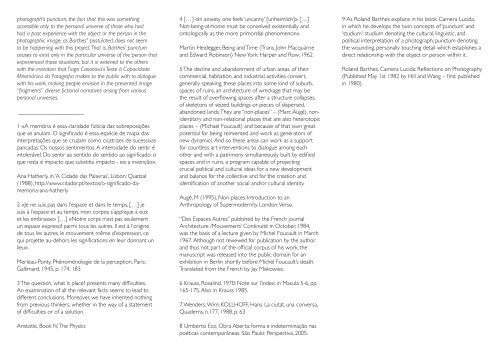PORTFÓLIO TIAGO CASANOVA
Create successful ePaper yourself
Turn your PDF publications into a flip-book with our unique Google optimized e-Paper software.
photograph’s punctum, the fact that this was something<br />
accessible only to the personal universe of those who had<br />
had a past experience with the object or the person in the<br />
photographic image, as Barthes 9 postulated, does not seem<br />
to be happening with this project. That is, Barthes’ punctum<br />
ceases to exist only in the particular universe of the person that<br />
experienced those situations, but it is widened to the others<br />
with the invitation that Tiago Casanova’s Teste à Capacidade<br />
Mnemónica da Fotografia makes to the public with to dialogue<br />
with his work, making people envision in the presented image<br />
“fragments” diverse fictional narratives arising from various<br />
personal universes.<br />
______________________<br />
1 «A memória é essa claridade fictícia das sobreposições<br />
que se anulam. O significado é essa espécie de mapa das<br />
interpretações que se cruzam como cicatrizes de sucessivas<br />
pancadas. Os nossos sentimentos. A intensidade do sentir é<br />
intolerável. Do sentir ao sentido do sentido ao significado: o<br />
que resta é impacto que substitui impacto - eis a invenção».<br />
Ana Hatherly, in ‘A Cidade das Palavras’, Lisbon: Quetzal<br />
(1988); http://www.citador.pt/textos/o-significado-damemoria-ana-hatherly<br />
2 «Je ne suis pas dans l’espace et dans le temps, […] je<br />
suis à l’espace et au temps, mon corpos s’applique à eux<br />
et les embrasse» […] «Notre corps n’est pas seulement<br />
un espace expressif parmi tous les autres. Il est à l’origine<br />
de tous les autres, le mouvement même d’expression, ce<br />
qui projette au-dehors les significations en leur donnant un<br />
lieu».<br />
Merleau-Ponty, Phénoménologie de la perception, Paris,<br />
Gallimard, 1945, p. 174, 183<br />
3 The question, what is place? presents many difficulties.<br />
An examination of all the relevant facts seems to lead to<br />
different conclusions. Moreover, we have inherited nothing<br />
from previous thinkers, whether in the way of a statement<br />
of difficulties or of a solution.<br />
Aristotle, Book IV, The Physics<br />
4 […] «In anxiety one feels ‘uncanny’ [unheimlich]» […]<br />
Not-being-at-home must be conceived existentially and<br />
ontologically as the more primordial phenomenon».<br />
Martin Heidegger, Being and Time (Trans. John Macquarrie<br />
and Edward Robinson) New York: Harper and Row, 1962<br />
5 The decline and abandonment of urban areas, of their<br />
commercial, habitation, and industrial activities convert,<br />
generally speaking, these places into some kind of suburb,<br />
spaces of ruins, an architecture of wreckage that may be<br />
the result of overflowing spaces after a structure collapses,<br />
of skeletons of seized buildings or pieces of dispersed,<br />
abandoned lands. They are “non-places” – (Marc Augé), nonidentitary<br />
and non-relational places that are also heterotopic<br />
places – (Michael Foucault) and because of that own great<br />
potential for being reinvented and work as generators of<br />
new dynamics. And so these areas can work as a support<br />
for countless art interventions to dialogue among each<br />
other and with a patrimony simultaneously built by edified<br />
spaces and in ruins, a program capable of projecting<br />
crucial political and cultural ideas for a new development<br />
and balance for the collective and for the creation and<br />
identification of another social and/or cultural identity.<br />
Augé, M (1995), Non-places: Introduction to an<br />
Anthropology of Supermodernity. London: Verso.<br />
“Des Espaces Autres” published by the French journal<br />
Architecture /Mouvement/ Continuité in October, 1984,<br />
was the basis of a lecture given by Michel Foucault in March<br />
1967. Although not reviewed for publication by the author<br />
and thus not part of the official corpus of his work, the<br />
manuscript was released into the public domain for an<br />
exhibition in Berlin shortly before Michel Foucault’s death.<br />
Translated from the French by Jay Miskowiec.<br />
6 Krauss, Rosalind, 1970: Note sur l’index, in Macula 5-6, pp.<br />
165-175. Also in Krauss 1985.<br />
7 Wenders, Wim; KOLLHOFF, Hans. La ciutat, una conversa,<br />
Quaderns, n.177, 1988. p. 63<br />
8 Umberto Eco, Obra Aberta: forma e indeterminação nas<br />
poéticas contemporâneas. São Paulo: Perspectiva, 2005.<br />
9 As Roland Barthes explains in his book Camera Lucida,<br />
in which he develops the twin concepts of ‘punctum’ and<br />
‘studium’: studium denoting the cultural, linguistic, and<br />
political interpretation of a photograph; punctum denoting<br />
the wounding, personally touching detail which establishes a<br />
direct relationship with the object or person within it.<br />
Roland Barthes, Camera Lucida: Reflections on Photography<br />
(Published May 1st 1982 by Hill and Wang – first published<br />
in 1980).


















